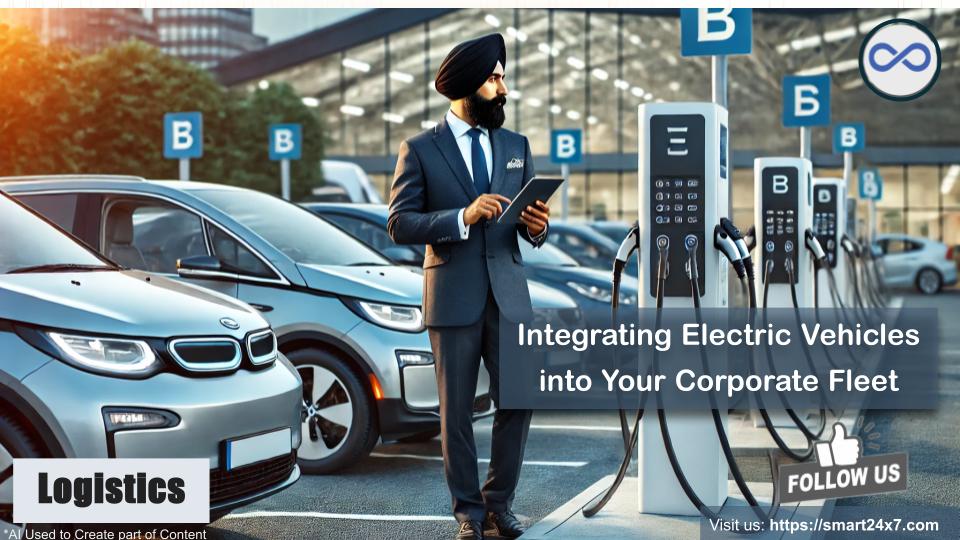The shift towards electric vehicles (EVs) is accelerating as companies seek sustainable and cost-effective solutions for their transportation needs. Integrating EVs into your corporate fleet not only helps reduce your carbon footprint but also offers significant operational benefits. At Smart24x7, a leading transport management system, we provide comprehensive support to transport heads and procurement managers looking to transition to an electric vehicle fleet. Here’s how you can successfully integrate electric vehicles into your corporate fleet.
1. Assessing Fleet Needs and Goals
Understand Your Requirements:
- Fleet Size and Composition: Evaluate the size and composition of your current corporate fleet management to determine which vehicles can be replaced with EVs.
- Usage Patterns: Analyze the daily usage patterns of your fleet, including average trip lengths, load capacity, and driving conditions.
Set Clear Objectives:
- Sustainability Goals: Define your sustainability goals, such as reducing carbon emissions and achieving a specific percentage of electric vehicle fleet in your corporate operations.
- Cost Savings Targets: Set targets for reducing fuel and maintenance costs through the adoption of EVs in corporate fleet management.
2. Conducting a Cost-Benefit Analysis
Evaluate Financial Implications:
- Initial Investment: Calculate the upfront costs of purchasing or leasing electric vehicle fleet assets, including any available government incentives or subsidies.
- Operational Savings: Estimate the savings on fuel, maintenance, and operational costs over the lifespan of the EVs.
Consider Total Cost of Ownership (TCO):
- Depreciation Rates: Analyze the depreciation rates of electric vehicles compared to traditional vehicles in your corporate fleet management.
- Resale Value: Consider the potential resale value of EVs after a few years of use.
3. Building Charging Infrastructure
Plan for Charging Needs:
- Charging Stations: Determine the number and type of charging stations required to support your electric vehicle fleet.
- Location Planning: Identify optimal locations for installing charging stations, considering accessibility and convenience for drivers.
Explore Charging Solutions:
- Home and Workplace Charging: Provide charging solutions for employees who take vehicles home or need to charge at the workplace.
- Public Charging Networks: Utilize public charging networks to supplement your corporate fleet’s charging infrastructure.
4. Selecting the Right EVs for Your Fleet
Consider Vehicle Specifications:
- Range and Battery Life: Choose EVs with sufficient range and battery life to meet your corporate fleet management needs.
- Load Capacity and Performance: Ensure the selected EVs can handle the load capacity and performance requirements of your operations.
Evaluate Available Models:
- Market Research: Conduct thorough market research to identify electric vehicle models that best fit your fleet’s needs.
- Vendor Partnerships: Establish partnerships with reputable EV manufacturers and suppliers to secure the best deals and support for your transport management system.
5. Training and Educating Staff
Driver Training Programs:
- EV Operation Training: Provide comprehensive training for drivers on operating EVs, including charging protocols and efficient driving techniques.
- Safety Training: Ensure drivers are trained on EV safety measures, such as handling battery-related emergencies.
Maintenance Staff Training:
- Technical Training: Train your maintenance staff on the technical aspects of electric vehicle maintenance and repair.
- Partnership with Service Providers: Partner with EV service providers for specialized maintenance and support for your corporate fleet management.
6. Implementing a Monitoring and Management System
Leverage Smart24x7’s Transport Management System:
- Real-Time Monitoring: Utilize our platform to monitor the performance and status of your electric vehicle fleet in real-time.
- Data Analytics: Analyze data on vehicle usage, charging patterns, and maintenance needs to optimize fleet operations.
Integrate with Fleet Management Tools:
- Seamless Integration: Ensure your EV fleet integrates seamlessly with existing corporate fleet management tools and software.
- Customizable Reports: Generate customizable reports to track key performance metrics and make informed decisions.
7. Addressing Challenges and Mitigating Risks
Plan for Contingencies:
- Range Anxiety Solutions: Implement strategies to alleviate range anxiety, such as providing access to emergency charging stations.
- Backup Options: Maintain a small number of traditional vehicles as backups during the transition period.
Stay Updated with Regulations:
- Compliance Monitoring: Stay informed about regulatory changes related to EVs and ensure compliance with all relevant standards in corporate fleet management.
- Incentives and Policies: Take advantage of government incentives and policies that support the adoption of electric vehicles in corporate fleets.
Integrating electric vehicles into your corporate fleet is a strategic move that offers environmental, financial, and operational benefits. By following these steps, transport heads and procurement managers can ensure a smooth and successful transition to an electric vehicle fleet. At Smart24x7, we are committed to supporting your journey towards sustainability with our advanced transport management solutions.
Smart24x7 has been incubated by Smart Group India, underscoring our dedication to innovation and excellence in corporate fleet management. Embrace the future of transportation with Smart24x7 and lead the way in sustainable fleet management.
